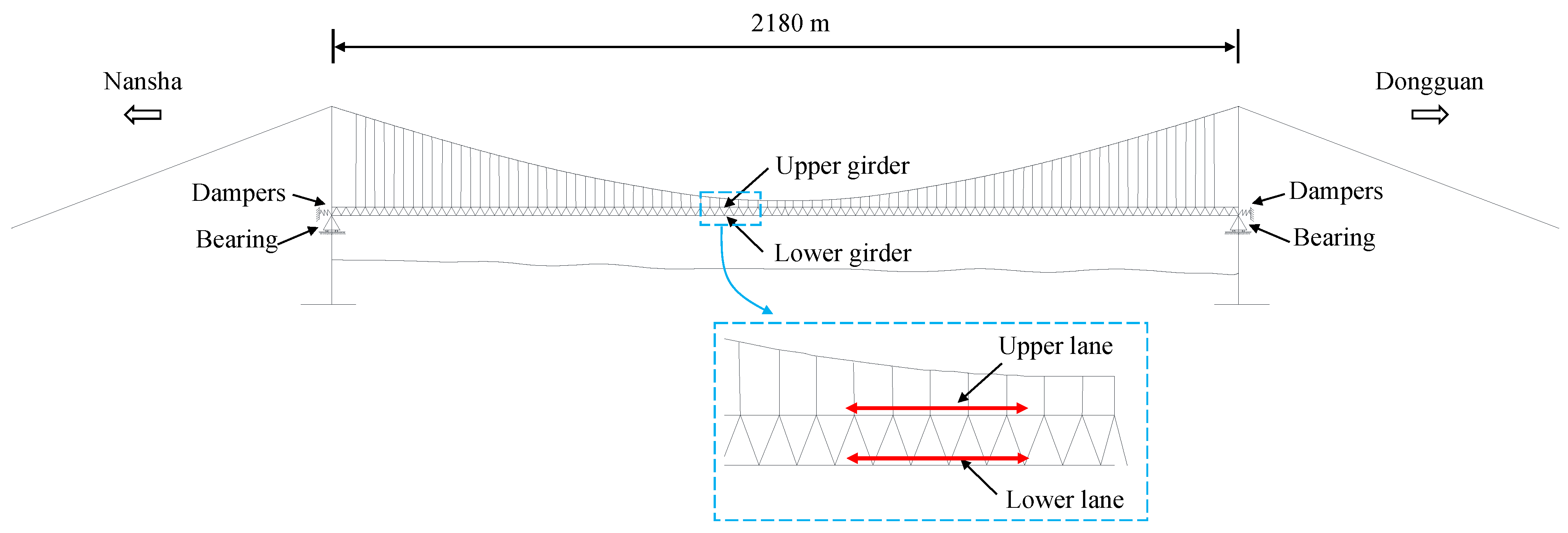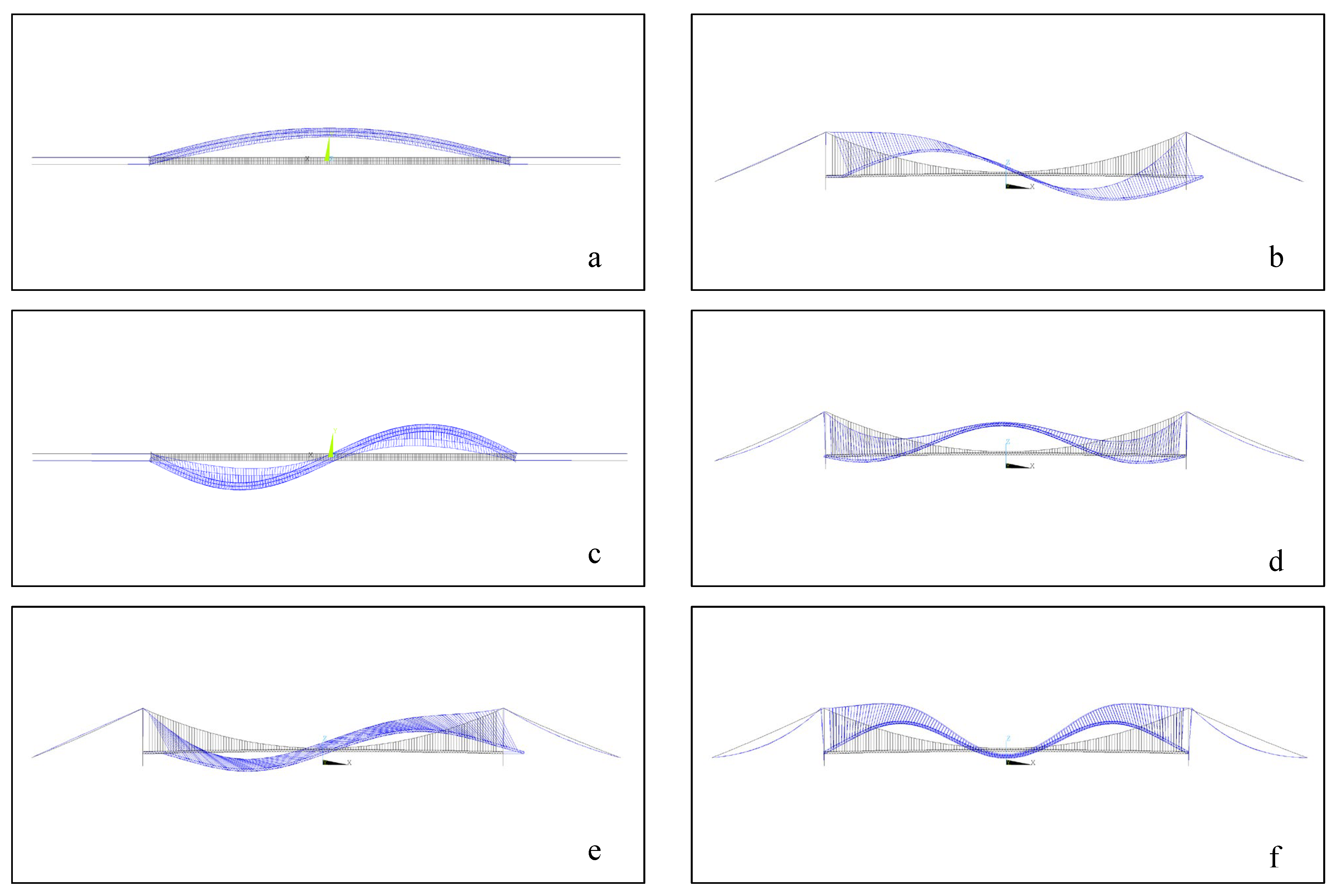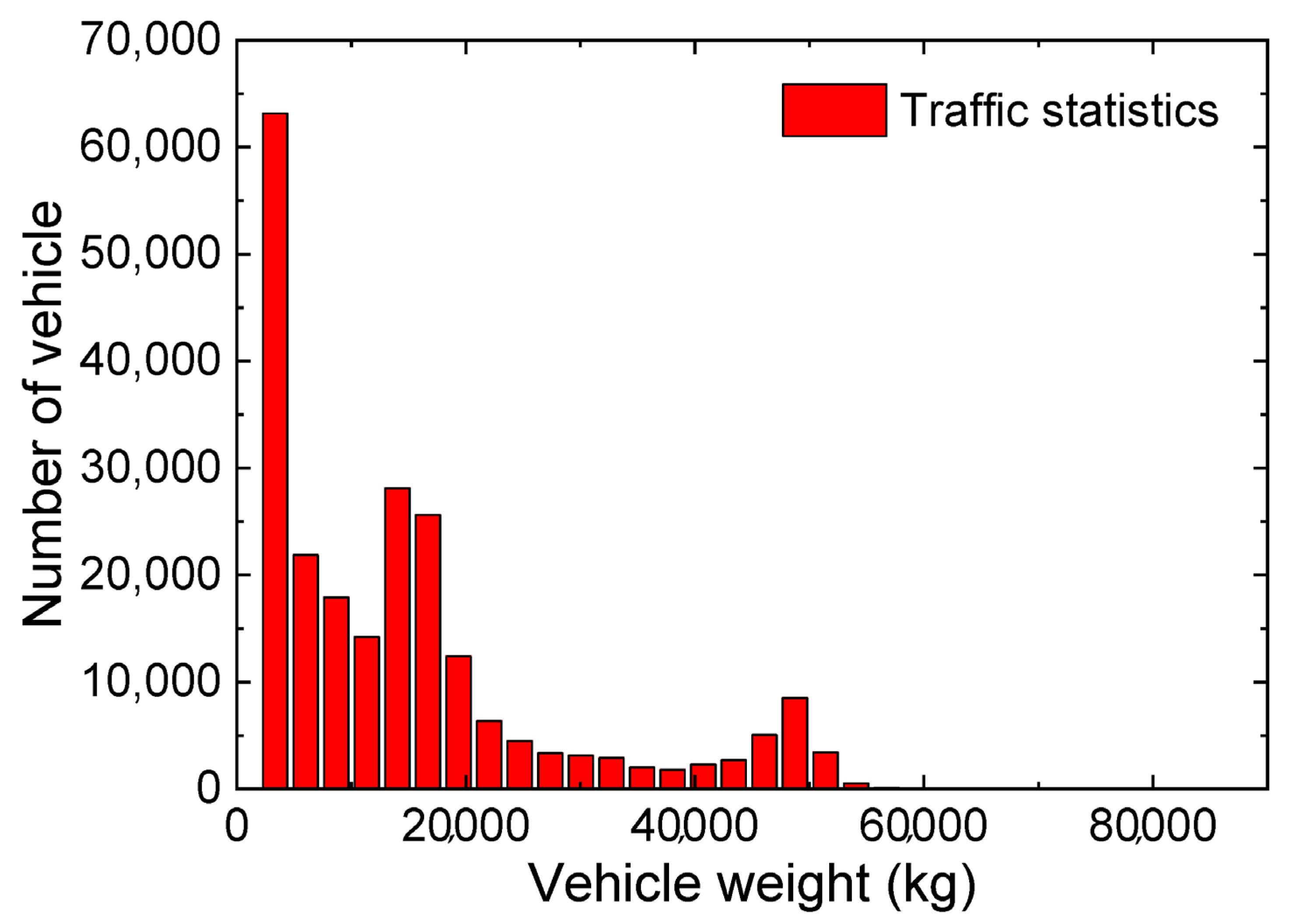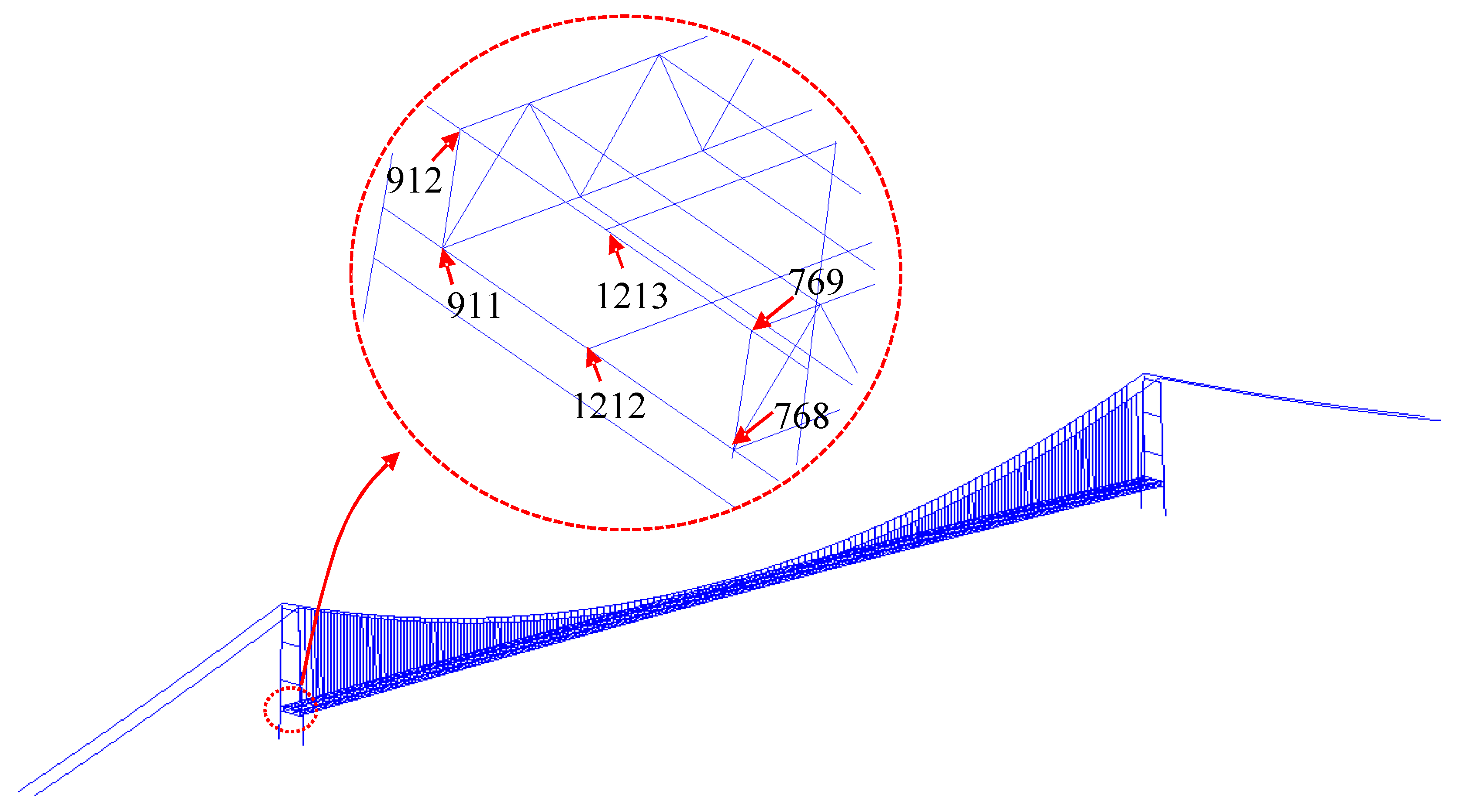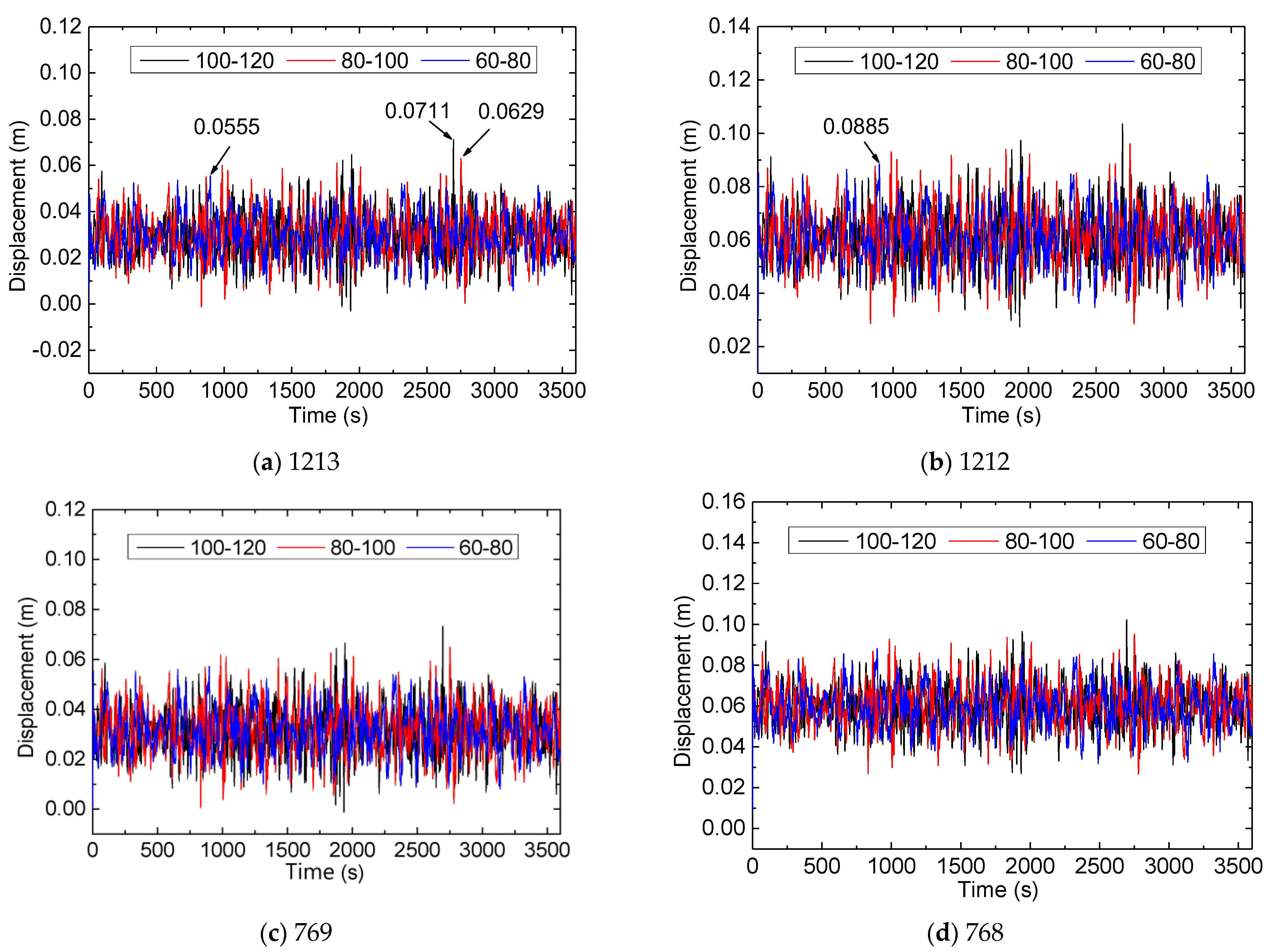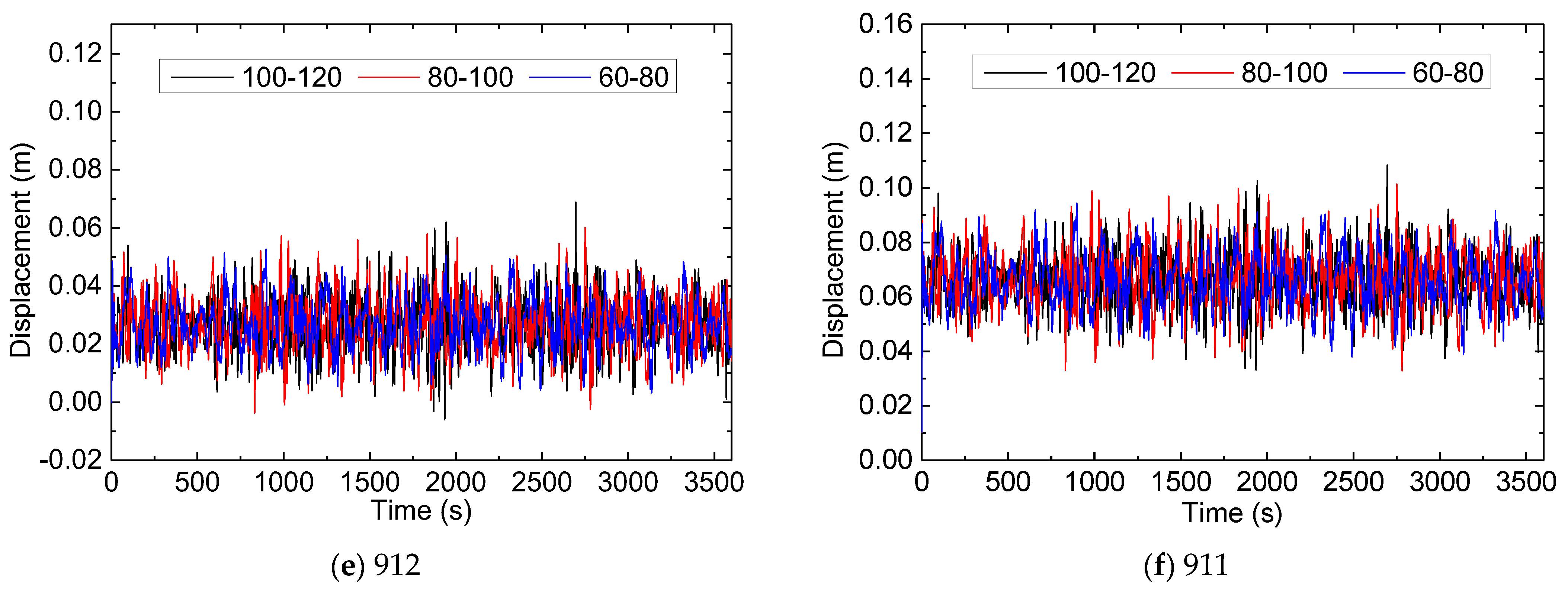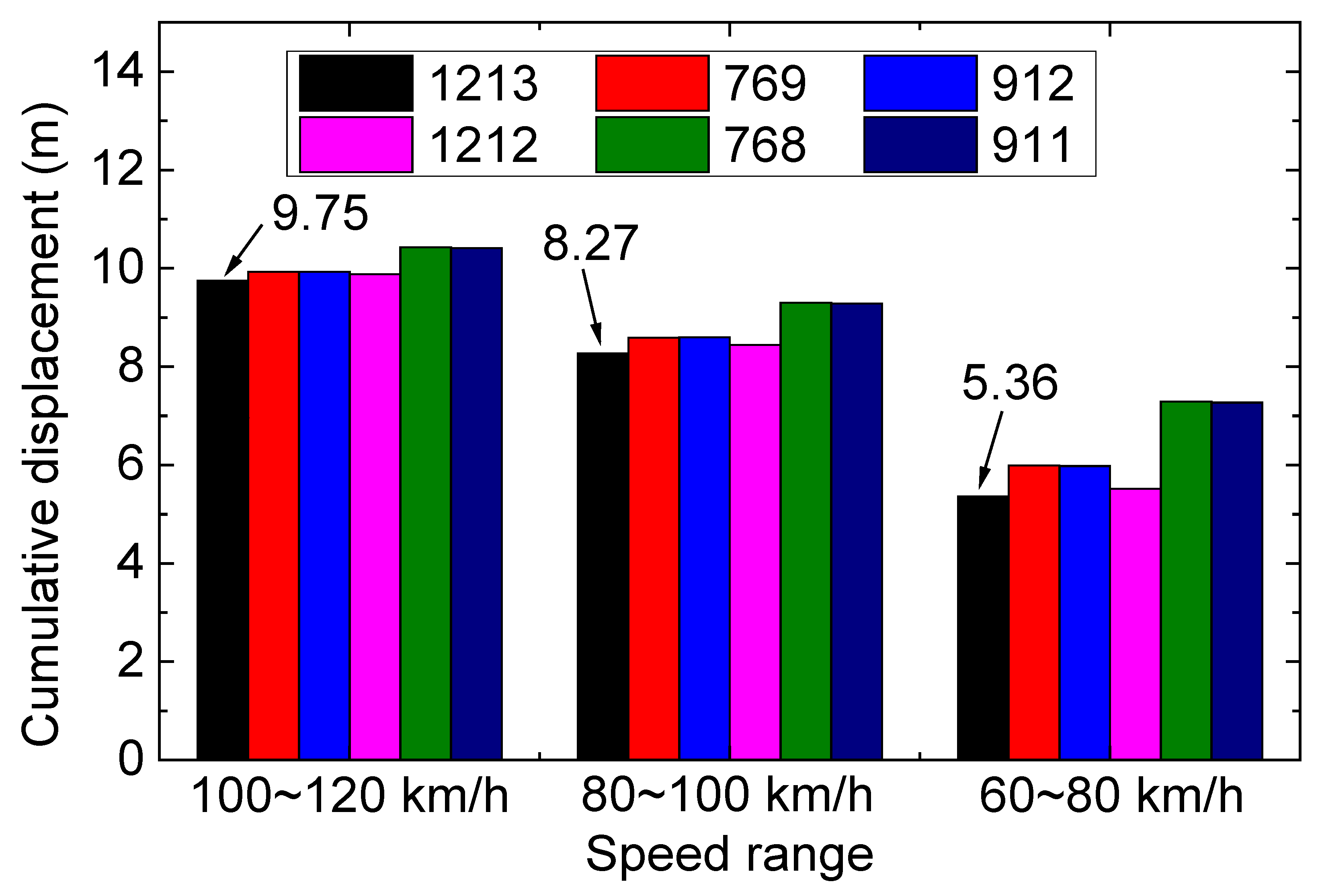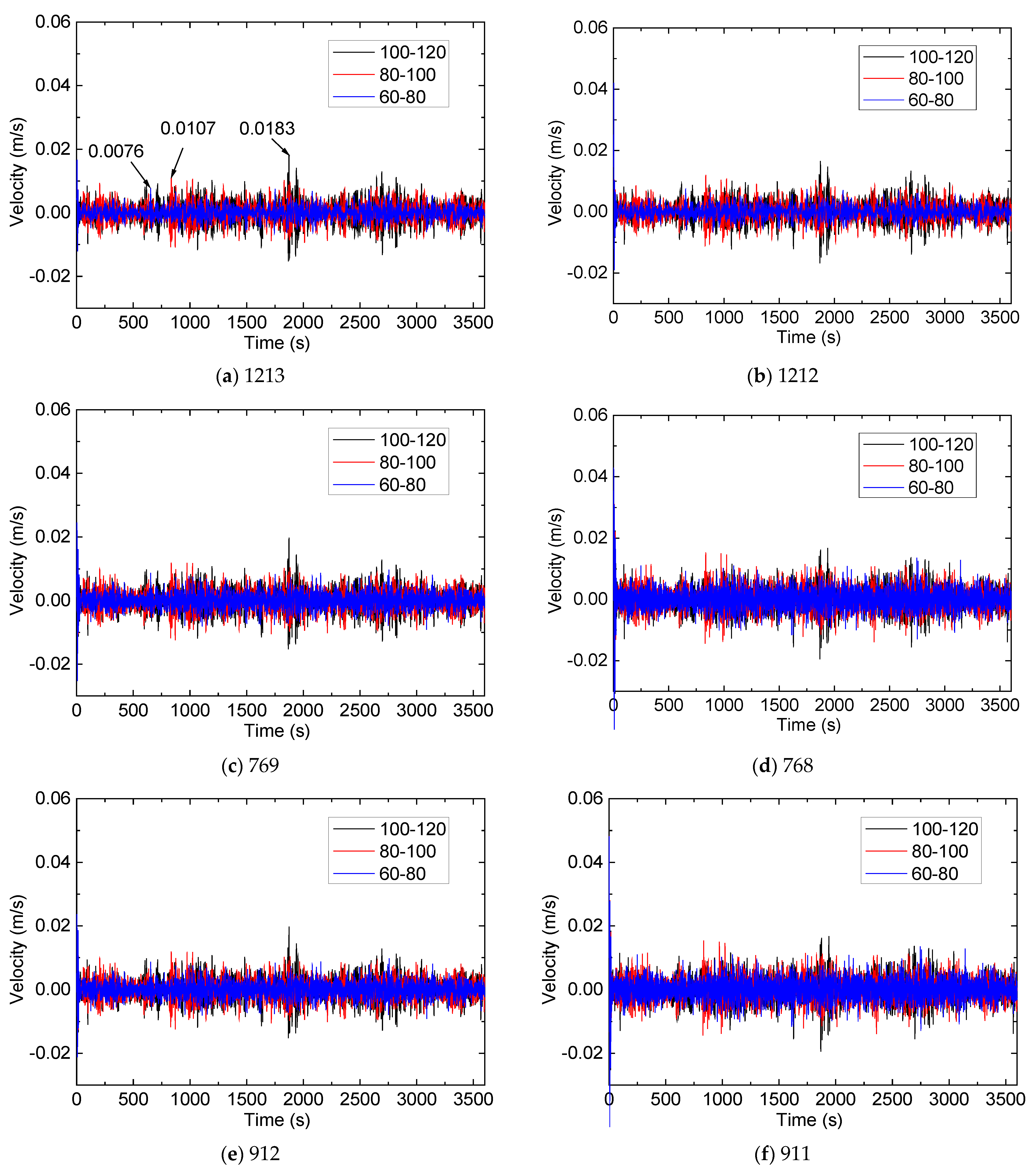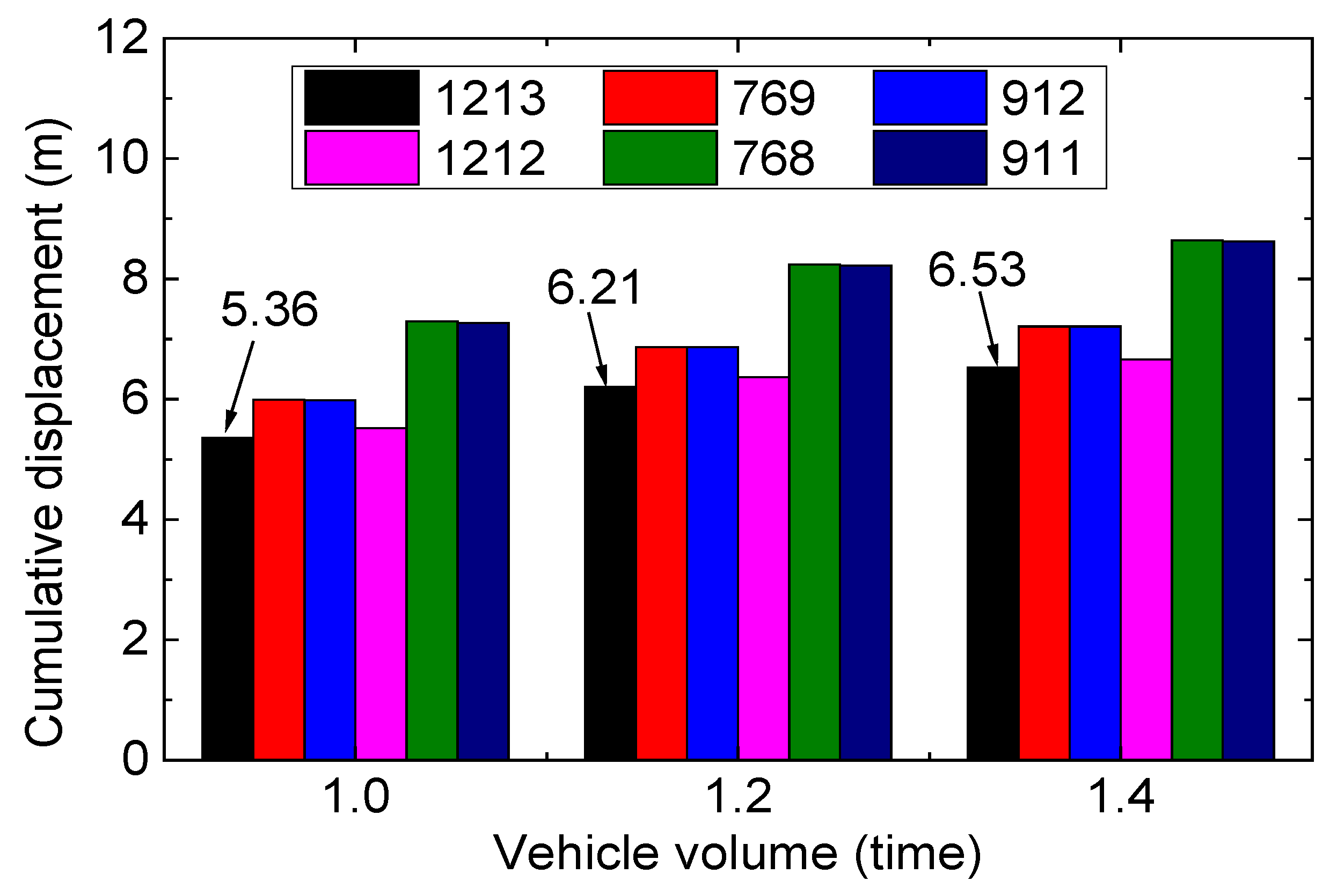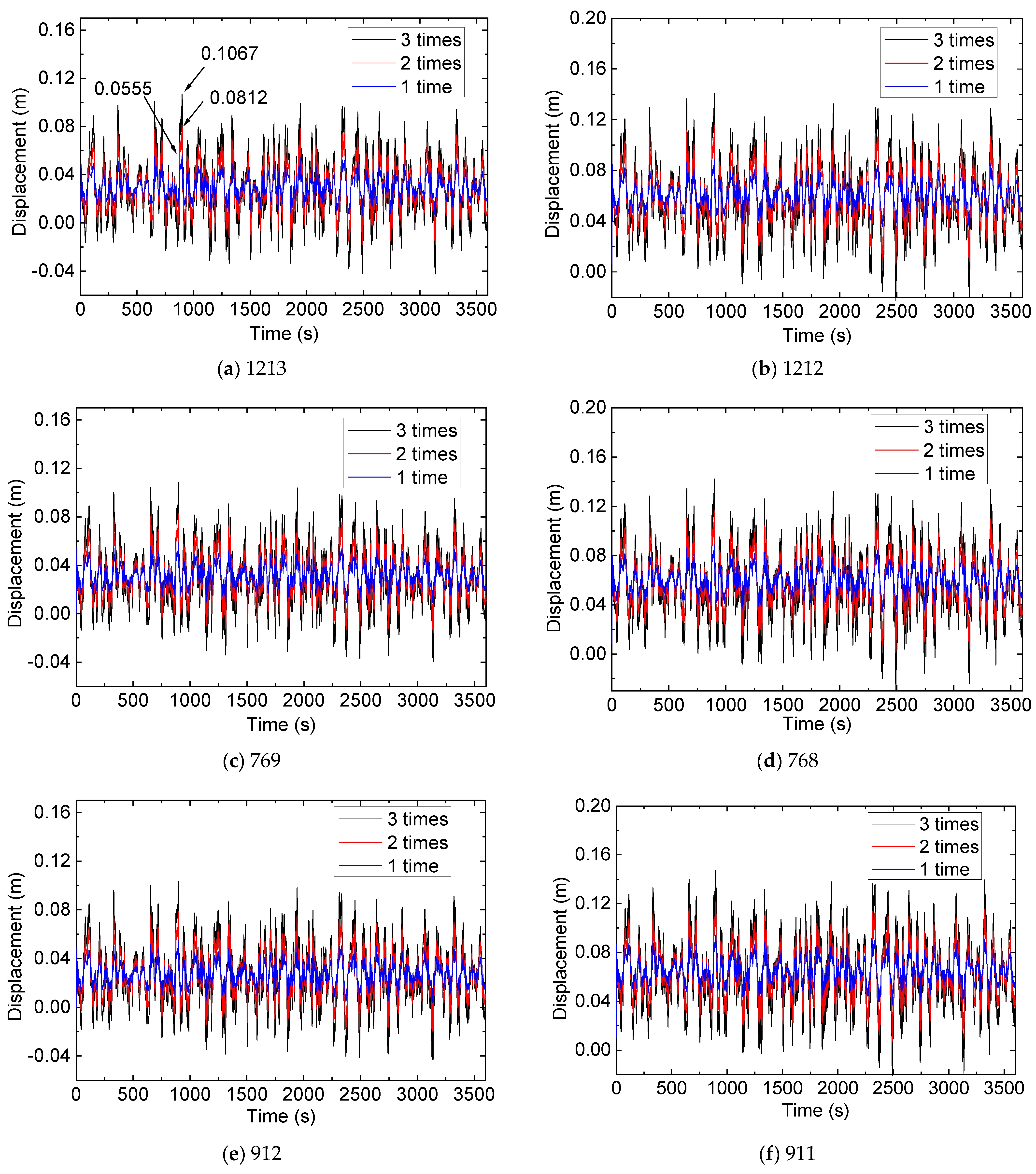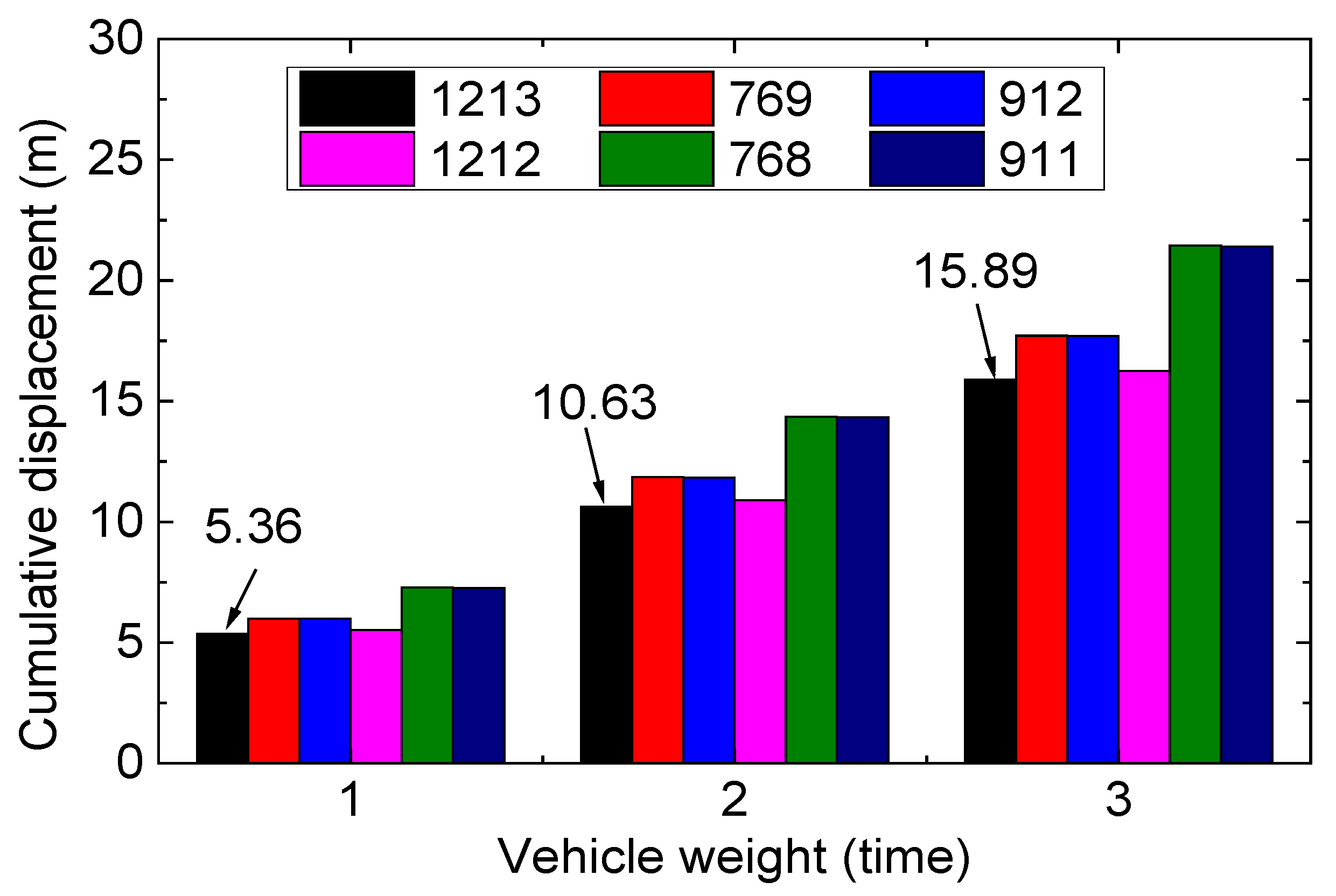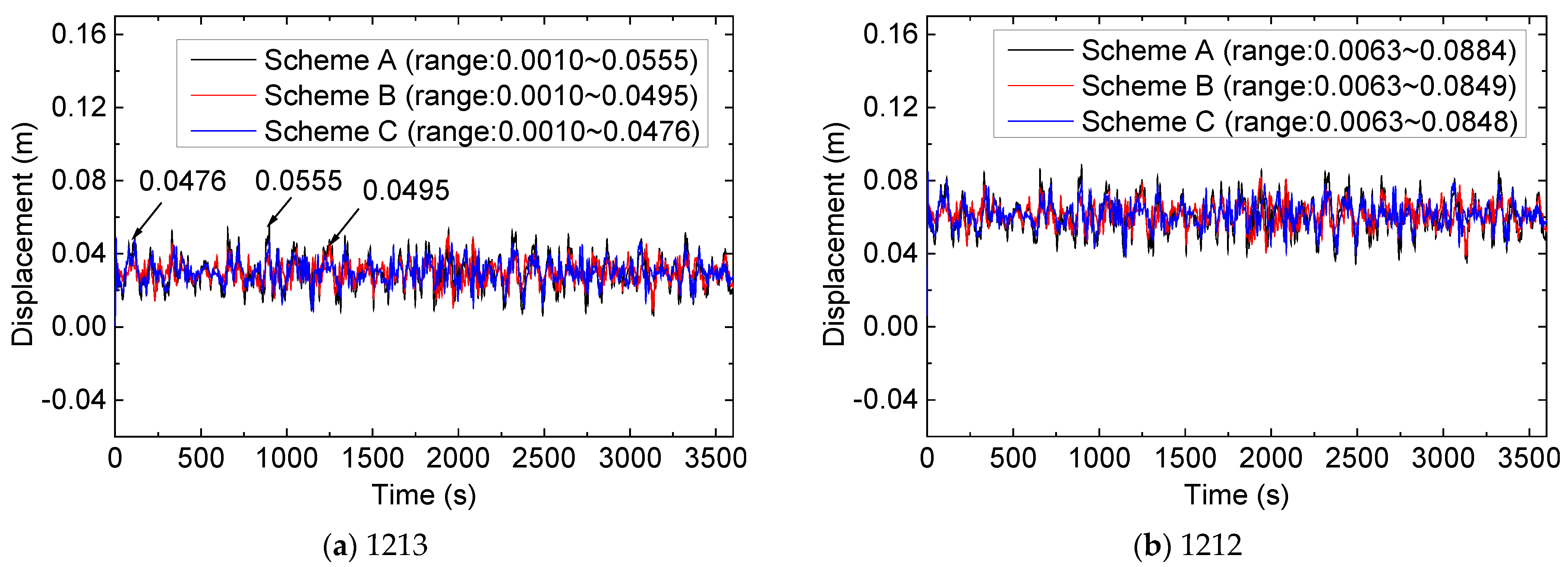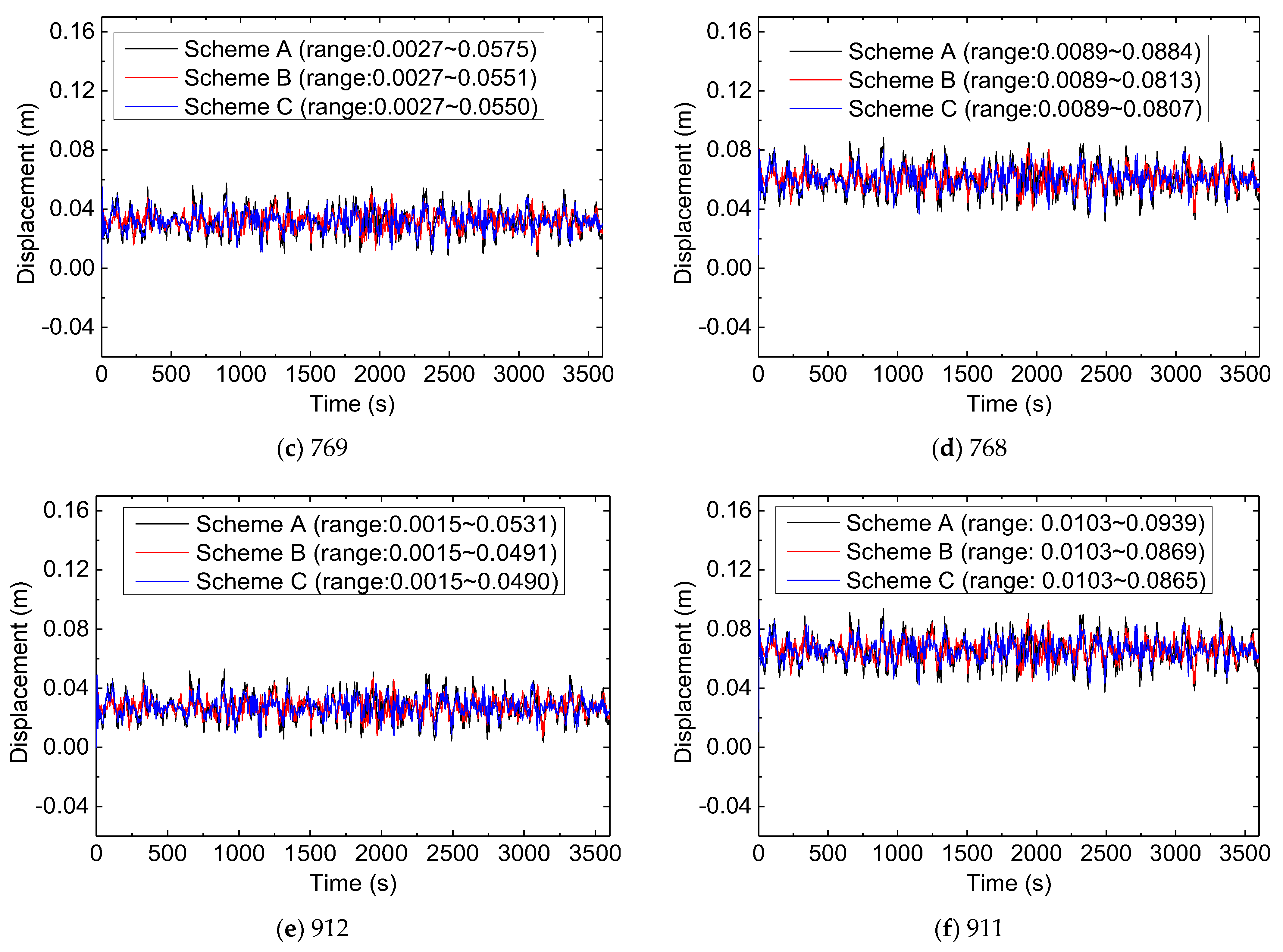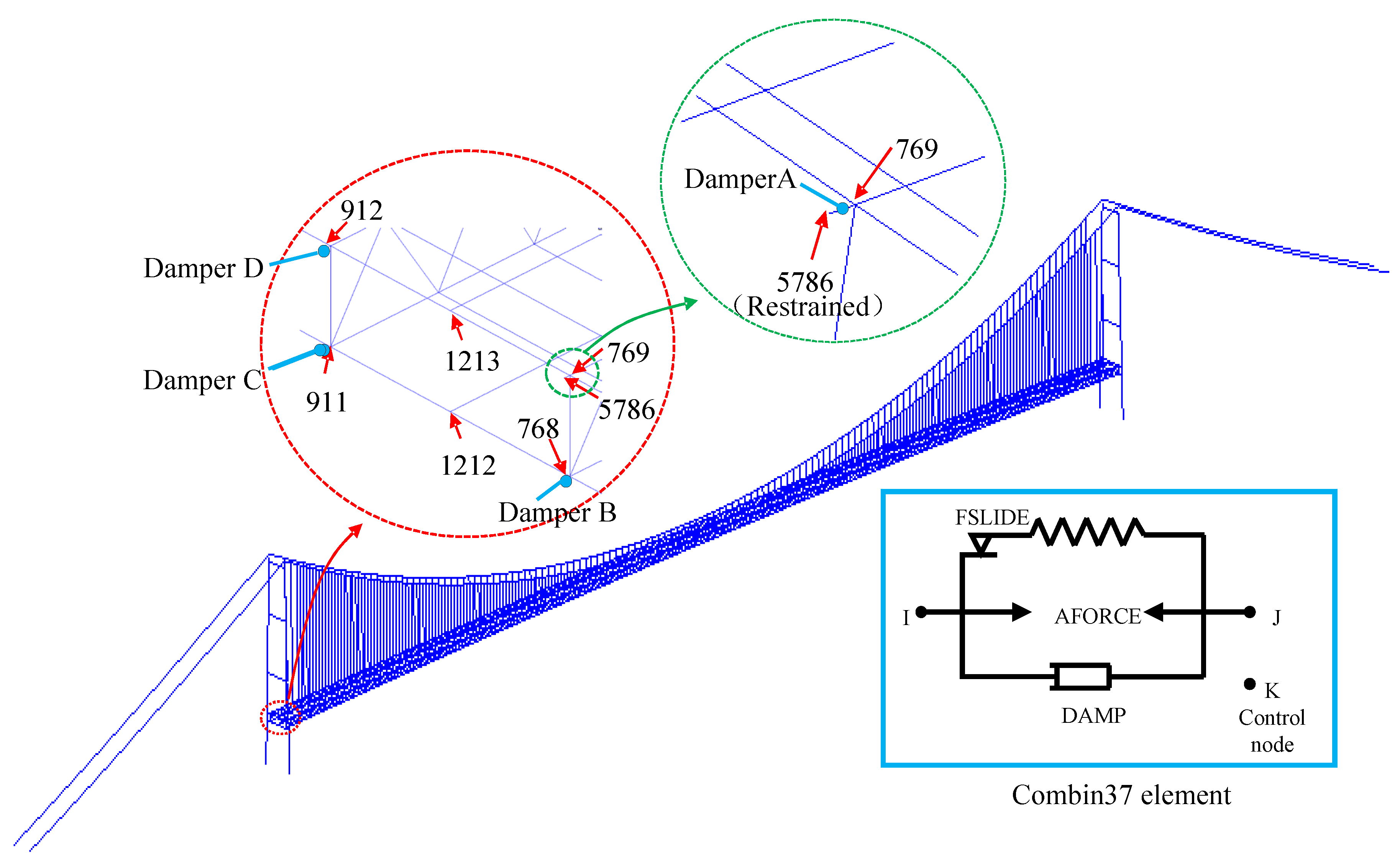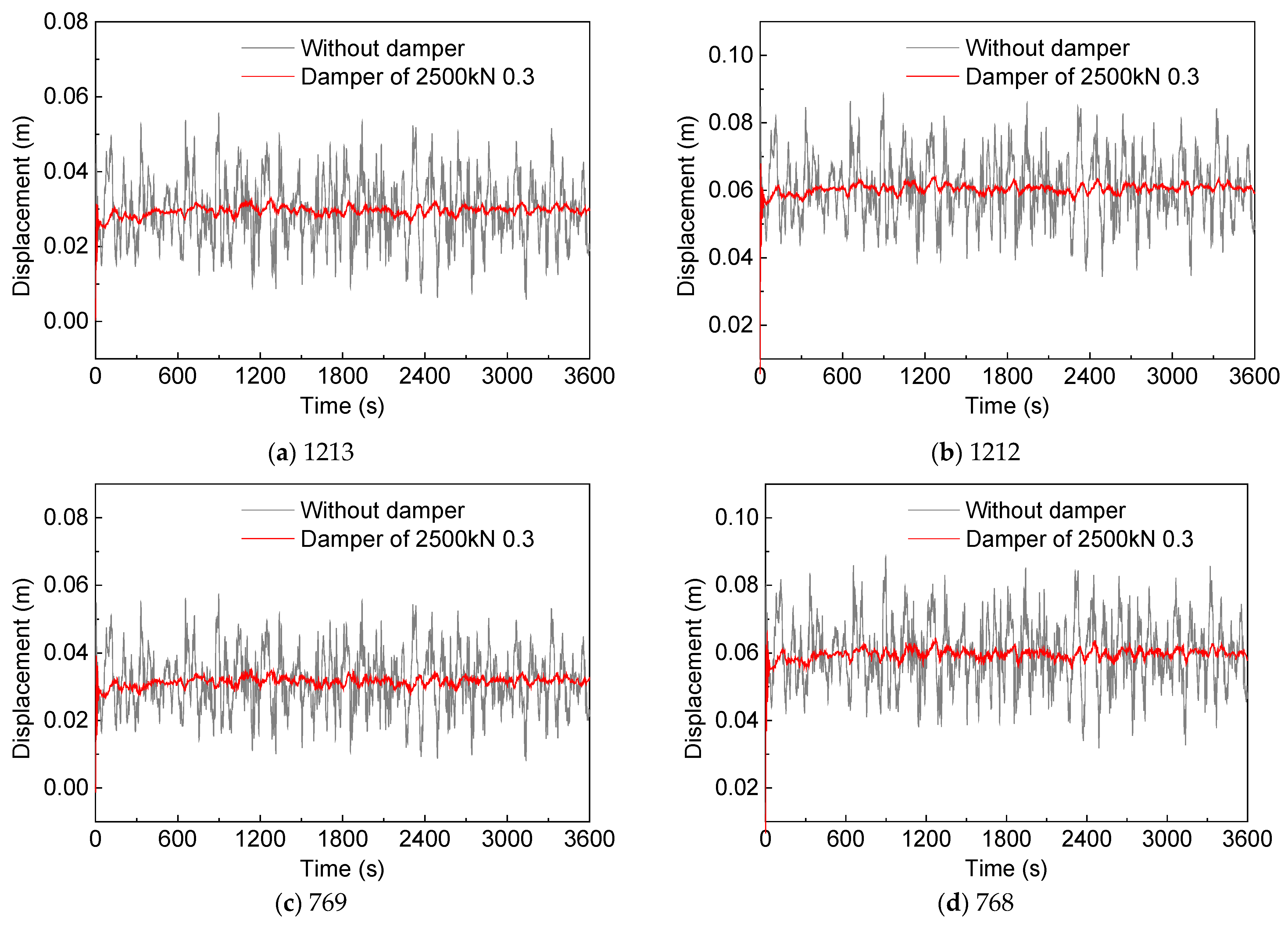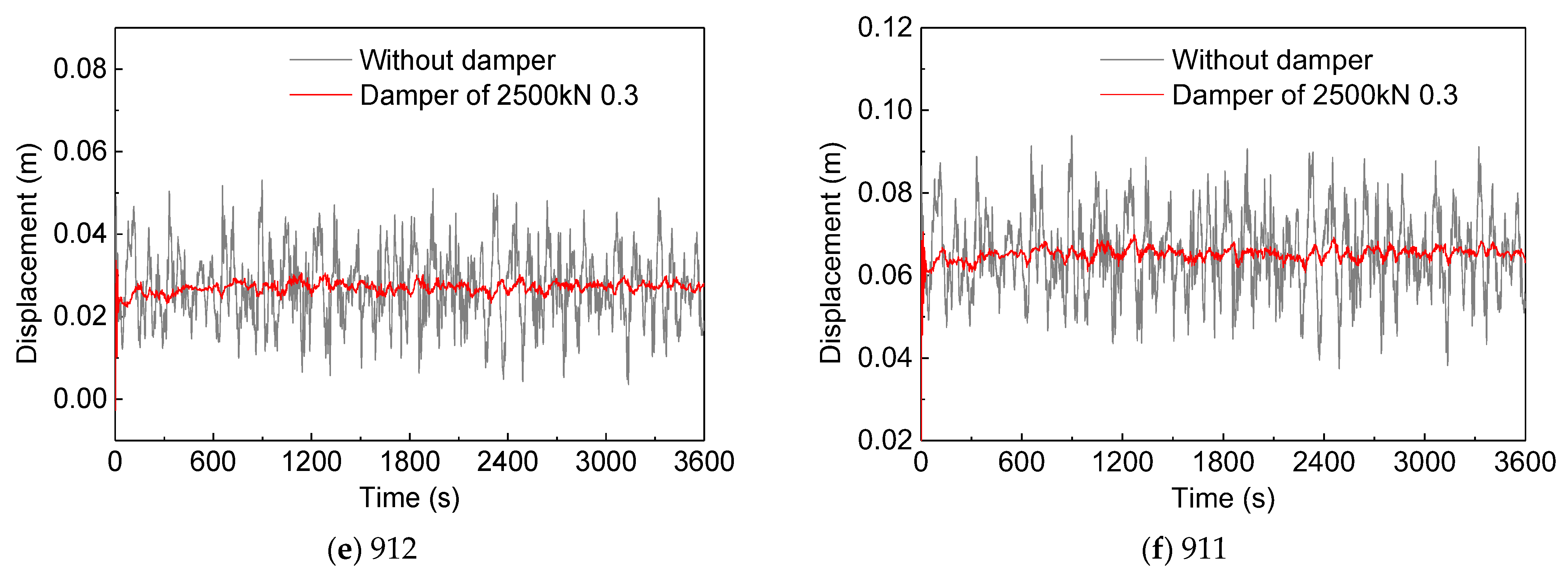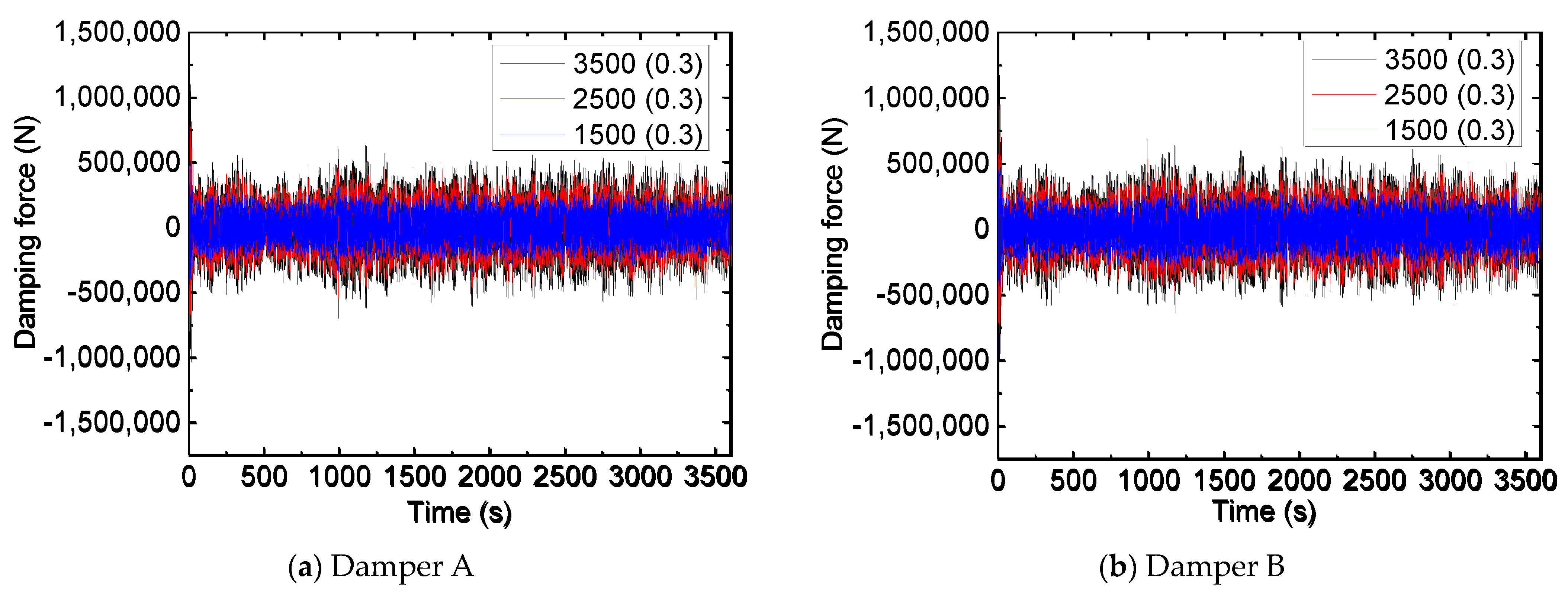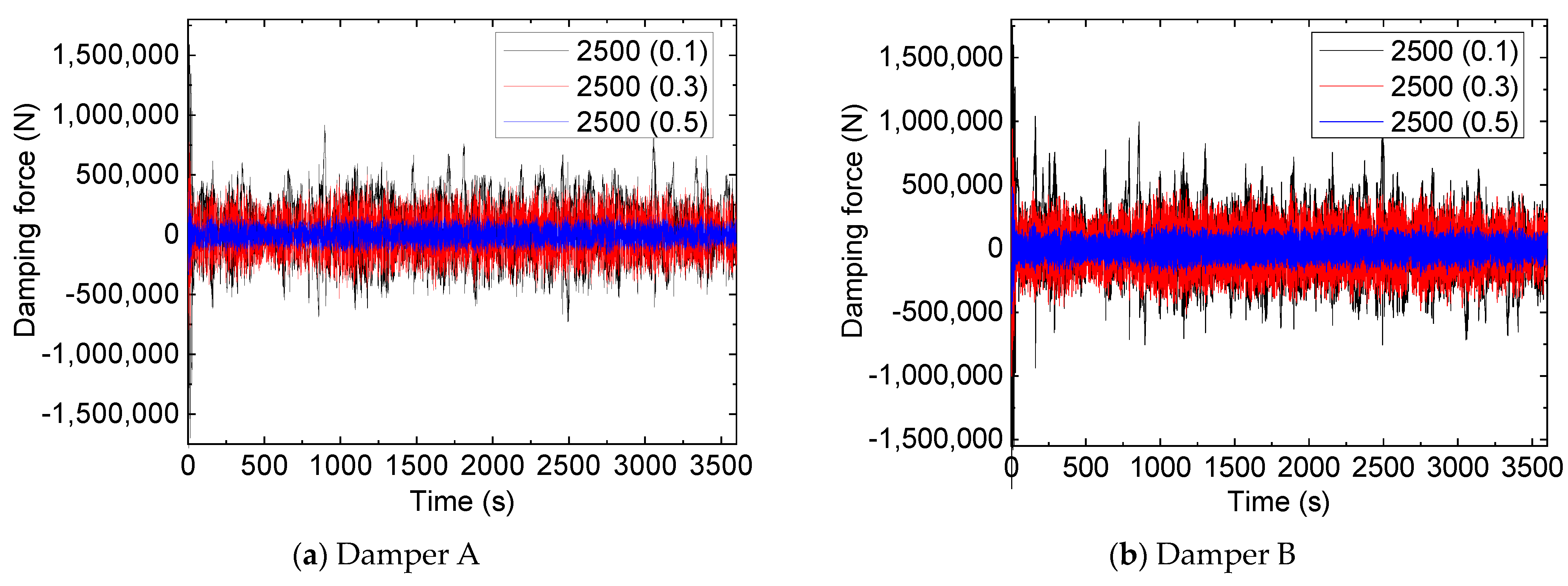1. Introduction
The suspension bridge has emerged as one of the most prominent long-span bridge types globally due to its inherent advantages, such as lightweight construction, simple force transmission, and easy formation of long-span bridges [
1,
2,
3]. However, long-span suspension bridges exhibit low vibration frequencies and small structural damping, leading to significant vibration amplitudes that pose a threat to the safety and performance of the bridge structures [
2,
4,
5,
6,
7,
8].
In long-span bridges, the significant longitudinal movement of the main girder can detrimentally impact the structural health and performance of the bridge. Relevant studies have highlighted that frequent and uneven longitudinal movement of the bridge is the primary contributor to the early damage or destruction of the expansion joints [
9,
10,
11], with vehicle loads representing one of the most frequently encountered external loads [
3,
12,
13,
14].
To investigate the dynamic response of bridges under different loads, several research studies have been conducted. For instance, Xu et al. (2003) developed a framework for predicting the dynamic response of long suspension bridges to running loads using the Finite Element (FE) method, highlighting that the extent of the dynamic response was influenced by the speed of moving loads [
15]. Malm and Andersson (2006) utilized field testing and simulation to evaluate the dynamic effects on a tied-arch railway bridge during train passages [
16]. However, as there exists a disparity between the loading of FE and the actual load, the model results may differ significantly from monitoring results, emphasizing the importance of simulating actual loading. Kwon et al. (2008) presented a dynamic interaction analysis of urban vehicle and guideway suspension bridges, demonstrating that vehicle speed represented an important parameter for the vibration of a vehicle running on the bridge due to the strong interaction between the vehicle and the bridge [
17]. Kaliyaperumal et al. (2011) performed dynamic analyses of an actual bridge in Sweden and compared them with field tests, suggesting that using a combination of beam and shell elements was an adequate way to capture the dynamic behavior of a bridge [
18]. Madrazo-Aguirre et al. (2015) conducted a dynamic analysis of steel-concrete composite under-deck cable-stayed bridges under the action of moving loads, revealing that relatively high accelerations occur, which could be amplified by large load eccentricities [
19].
These corresponding dynamic analyses have provided methods to study the dynamic response of the bridges, and several conclusions have been reported. However, the dynamic study of traffic loads under actual loads (especially the random traffic flow that is closer to real conditions) is relatively rare.
In this paper, a randomized traffic analysis procedure is proposed, and numerical simulations are utilized to investigate the dynamic responses of a long-span double-deck suspension bridge under random traffic loadings. The impact of various traffic parameters, such as vehicle speed, traffic volume, traffic weight, and passing girder location, on the longitudinal movement of the girders is thoroughly examined. Additionally, the efficacy of incorporating fluid viscous dampers through the Combin37 element in ANSYS to mitigate the longitudinal movement of the girders is explored, shedding light on their effectiveness.
3. Dynamic Analysis of Random Traffic Flow
3.1. Generation of Random Traffic Flow
In order to quantitatively analyze the dynamic response of the LDSB under actual random traffic loads, the traffic flow information of Nansha Bridge (located in Guangdong Province, China, adjacent to the LDSB) over a period of 14 days was used as the basis. Firstly, 230,371 vehicles for the Nansha Bridge over 14 days (7–21 March 2020) were adopted, which were collected by the monitoring platform of the abutment on the south side of Nansha Bridge, and hence 686 (230,371 ÷ 14 ÷ 24 = 686) vehicles entered the bridge from one end within one hour could be calculated. The vehicle weight distribution is shown in
Figure 3. From the vehicle weight histogram, it can be seen that the maximum traffic flow weight is obtained when the vehicle weight is between 0 and 3 tons (the number of passing vehicles in this weight range for 14 days is 63,164), and the average vehicle weight for this range is 2.3 tons.
Secondly, according to the weight of each vehicle weight range, the vehicle weight of each range within 1 h is generated proportionally (the higher the frequency, the greater the vehicle weight is generated). Then, the generated sampling data were dispersed randomly by MATLAB software, and the final random sampling data (which is named “SUM.txt”) was generated accordingly. In order to realize the random flow loading of the FE model, the final sampling data in “SUM.txt” were randomly distributed (via MATLAB software) according to the number of main beam nodes in the model, and the final random traffic load for the upper girder and bottom girder, i.e., “loads-top.txt” and “loads-bottom.txt”, were generated. It is worth noting that, during this procedure, the traffic loading data for different speed ranges (i.e., 60–80 km/h, 80–100 km/h, and 100–120 km/h) could be obtained by parameter setting. During this study, the original traffic flow with a speed range of 60–80 km/h was defined as the “reference traffic flow”. Finally, the loading analysis command was read in the ANSYS platform to realize the dynamic analysis of the LDSB under random traffic loading, and the analysis results could be extracted.
3.2. The Effect of Vehicle Speed Range
In order to analyze the girder longitudinal dynamic response of the initial (without dampers) large-span double-layered suspension bridge, the transient analysis of one hour of random traffic flow for 60–80 km/h (i.e., the reference traffic flow), 80–100 km/h, and 100–120 km/h speed ranges was conducted. During this analysis, 686 vehicles passed through each end (including the left end of the upper girder, the right end of the upper girder, the left end of the bottom girder, and the right end of the bottom girder) of the bridge, and the displacement time history of six nodes (i.e., 912, 1213, 769, 911, 1212, and 768 in
Figure 4) at the left end of the girders was extracted as shown in
Figure 5. Taking into account the symmetry of the model and the direction of traffic, the same conclusion can be drawn for the right-end nodes.
From
Figure 5, it is observed that the displacement of each node can be influenced by the traffic speed range, and the extreme value of node displacement under the loading of a higher vehicle speed (i.e., 100–120 km/h) will be significantly higher than that of a lower vehicle speed. For instance, the extreme value of node 1213 was 0.0711 m (for 100–120 km/h), whereas the ones for 60–80 km/h and 80–100 km/h were 0.0629 m and 0.0555 m, respectively.
Figure 6 plots the one hour cumulative displacement of the girder end nodes of the LDSB under the traffic flow for different speed ranges. Based on the cumulative displacements in
Figure 6, it is observed that the cumulative displacement of the end nodes of the girder can be affected by the passing traffic speed, and higher traffic speeds tend to result in more cumulative displacement of the end nodes of the girders. For example, the cumulative displacement of nodes 1213 in the speed ranges 100–120 km/h, 80–100 km/h, and 60–80 km/h was 9.75, 8.27, and 5.36 m, respectively. In addition, by comparing the cumulative displacement of nodes 1213 and 1212 under the same vehicle speed range, the cumulative displacement at node 1212 was always slightly higher than that of node 1213, indicating that the dynamic response of the bottom girder was more severe than that of the upper girder. For instance, under the vehicle speed range of 100–120 km/h, the cumulative displacements of 1213 and 1212 were 9.75 and 9.88 m, respectively.
Figure 7 shows the velocity time history curves of the six nodes at different speed ranges. Based on the real-time comparison of the velocity time histories of the six nodes, it can be seen that the velocity of the end of the girders will be significantly affected by the vehicle speed range. Similar to the change law of the displacement time history curve, a higher vehicle speed range will often lead to a larger node velocity. For example, for node 1213, the maximum velocity under the three speed ranges was 0.0183 (for 100–120 km/h), 0.0107 (for 80–100 km/h), and 0.0076 (for 60–80 km/h), respectively, and the change characteristics of other nodes (i.e., 1212, 769, 768, 912, and 911) were similar to 1213.
3.3. The Effect of Traffic Volume
In order to analyze the influence of traffic volume on the motion response of the LDSB, longitudinal dynamic analysis of the girder under different traffic volumes (1 time, 1.2 times, and 1.4 times vehicle volumes) based on the reference traffic flow was conducted, and the analyzed results of the one hour displacement time-history curves of the six nodes were plotted as
Figure 8. Similar shapes could be found in
Figure 9, and a greater magnitude of time-history data was obtained from calculation scenarios of 1.4 times the vehicle volume. The cumulative displacement of 1213 for the 1.4 times traffic volume was 6.53 m, whereas the cumulative displacements of 5.36 and 6.21 m were calculated by the 1 time and the 2 times traffic volumes, respectively. This phenomenon indicated that a larger traffic volume would cause the amplitude of the displacement curve to increase.
Figure 9 plots the one hour cumulative displacement of the girder end nodes of the LDSB under different vehicle volumes. Based on the cumulative displacements in
Figure 10, it is observed that the cumulative displacement of the end nodes of the girder can be affected by the passing vehicle volume, and bigger vehicle volumes tend to result in more cumulative displacement of the end nodes of the girders. For example, the cumulative displacement of the nodes 1213 of the 1 time, 1.2 times, and 1.4 times vehicle volumes was 5.36, 6.21, and 6.53 m, respectively.
3.4. The Effect of Traffic Weight
In order to analyze the influence of traffic volume on the motion response of the LDSB, longitudinal dynamic analysis of three traffic weights (i.e., 1 time, 2 times, and 3 times weights of the reference traffic flow) was conducted in this section. The analyzed results of the one hour displacement time-history curves and cumulative displacement of the six nodes are plotted in
Figure 10 and
Figure 11. Based on
Figure 11, it is observed that the displacement of each node can be remarkably affected by the traffic weight. For instance, for node 1213, the maximum displacement of the 1 time traffic weight (i.e., the reference traffic flow) was 0.555 m, whereas the ones of 2 times and 3 times traffic weights were 0.0812 and 0.1067 m (as
Figure 10a shows), respectively. Furthermore, by comparing the cumulative displacements of each node in
Figure 12, it is found that traffic flow with greater vehicle weight can induce a bigger cumulative displacement of the nodes. The cumulative displacement of 1213 for the 3 times traffic flow was 15.89 m, whereas the cumulative displacements of 5.36 and 10.63 m were calculated for the 1 time and the 2 times traffic flows, respectively. Therefore, it is suggested that in order to maintain the health of the bridge, it is advisable to monitor the weight of the vehicles passing on the bridge in time.
3.5. The Effect of the Location of the Passing Girder
In order to analyze the influence of the location of the passing girder on the motion response of the LDSB, a longitudinal dynamic analysis of three passing schemes was conducted in this section, which included that: (A) the upper and lower girders were imposed by the reference traffic flow at the same time; (B) the upper girder was imposed by the reference traffic flow, whereas the bottom girder was not open to traffic; and (C) the bottom girder was imposed by the reference traffic flow, whereas the upper girder was not open to traffic. The analyzed results of the one hour displacement time-history curves and cumulative displacement of the six nodes were plotted in
Figure 12 and
Figure 13. Through time-history analysis, it is found that the range of motion of the end nodes of the three conditions is roughly similar.
Due to the difference in the passing girder compared to scheme A, a significant difference in cumulative displacement was found in schemes B and C. For scheme A, the cumulative displacements of nodes 1213 and 1212 were 5.36 and 5.52 m, respectively (see
Figure 7); however, for scheme B, the cumulative displacements of 1213 and 1212 were 3.66 and 3.78, respectively. It shows that under the single girder loading method of scheme B, the movement range of the girder end was gentler than that of scheme A. This phenomenon indicated that, compared with a long-span bridge with a single main girder, the passing schemes of the double girders can remarkably increase the longitudinal dynamic response of the girder. Similar results could be found with the displacement of scheme C.
4. Displacement Control Based on Fluid-Viscous Dampers
4.1. Establishment of the Damping Model
Considering that vibration can significantly affect the behavior and safety of long-span bridges, the installation of dampers has become one of the most important methods for vibration reduction (Chen et al., 2022; Shi and Cai, 2008). In order to control the longitudinal movement of the long-span double-deck suspension bridge, the viscous damper (modeled by Combin37) was adopted in this study. The installation positions of the dampers are shown in
Figure 14. One damper was installed at each of the four end nodes of the main girders of the bridge. Taking the left girder as an example, the connecting nodes of the dampers were 769, 768, 912, and 911, respectively. It should be noted that the viscous damper constraint effect adopted in this study was based on the ideal nonlinear force-velocity damping constraint model, and the problems in practical application caused by oil leakage and damping degradation failure at low speed are left for further study.
In order to investigate the restraining effect of dampers on the longitudinal movement of the LDSB, eight viscous dampers were installed at each end of the girders (including the left end and right end) of this 3D FE, and two dampers were installed at each end of the upper and lower main girders. According to the definition of the Combin37 element, the damping force is stimulated by the movement status of the control node. Therefore, for each damper, the control node was set at each girder end, that is, 769, 768, 912, and 911 of the left ends. In ANSYS, the combin37 element is a unidirectional element with the capability of turning on and off during an analysis, through which the damping can be controlled as a function of velocity, as depicted by Equation (1).
where
c is the damping coefficient;
is the damping exponent; and
is the relative displacement velocity between the two ends of the damper. Other interacting nonlinear effects, such as the P-d effect and large displacements, were all considered in the calculation.
4.2. The Movement of the Girder Ends Is Constrained by Dampers
Eight fluid viscous dampers were installed on the LDSB model, and the reference traffic flow was applied to both of the girders bilaterally. The damping coefficient and constant exponent were defined as 2500 kN and 0.3, respectively, and based on the transient analysis, the longitudinal displacement timing data of the end nodes can be calculated. Taking into account the symmetry of the model and traffic loads, the nodes of the left end (i.e., 1213, 1212, 769, 768, 912, and 911) were discussed.
Figure 15 plots the displacement time-history curves of the six nodes before and after the installation of the dampers under the reference random traffic loading. From
Figure 15, it is found that after installing the fluid viscous dampers, the displacement range of each node has been significantly reduced. For node 1213 as the instance, the displacement range for the original model (i.e., without damper) was approximately 0.010–0.056 m, whereas the displacement range of the constrained model (i.e., installed dampers) was about 0.025–0.033 m. This phenomenon shows the reduction of the dynamic response of the installed dampers.
Table 2 lists the one hour cumulative displacement of the six nodes before and after the installation of the dampers. Compared with the original model, a significant reduction in cumulative displacement could be found in the constrained model. For the constrained model, the cumulative displacement range of the end nodes was between 0.75 and 1.40 m, and the minimum value of the cumulative displacement of 0.75 m was adopted for node 1213. By the calculation of the reduction ratio of the end node cumulative displacement before and after the installation of damping devices, it can be concluded that the most remarkable reduction was obtained by node 1213, with a reduced rate of 86%, indicating the effects of the fluid viscous damping device on reducing the longitudinal displacement of the long-span bridge.
4.3. Influence of the Damping Coefficient
In order to study the effects of the damping coefficient on the dynamic response of the girder under the constraints of the fluid viscous dampers, the girder response of the 1500 kN (constant exponent of 0.3) and 3500 kN (constant exponent of 0.3) configurations of dampers was analyzed and discussed.
Table 3 lists the one hour accumulation of the six nodes for three types of damping coefficients (1500, 2500, and 3500 kN) under the reference random traffic loading. The smallest cumulative displacement (calculated as 0.62 m) was adopted by node 1213 under the configuration of 3500 kN dampers. By comparison of the cumulative displacement for the three damping configurations, it is found that the change of the damping coefficient can influence the cumulative displacement of the girders significantly, and the larger damping coefficients (e.g., 3500 kN) were defined, the smaller displacements could be induced.
Figure 16 plots the time-history curves of the damping force of the fluid viscous dampers A and B for each model under the reference random traffic loading. From
Figure 16, different damping forces could be adopted by the three damping configurations. The ranges of the damping force for damper A were (−345 kN, 314 kN), (−535 kN, 503 kN), and (−693 kN, 631 kN), which were calculated by the damping configuration of 1500 kN (0.3), 2500 kN (0.3), and 3500 kN (0.3), respectively. The difference in damping force range reflected the effect of the damping coefficient; therefore, in order to reduce the displacement of the girder end, it is recommended to increase the damping coefficient of dampers appropriately.
4.4. Influence of the Damping Exponent
Based on Equation (1), the damping exponent is the other parameter that can influence the damping force. In order to investigate the effect of the damping exponent on the dynamic response of the girder end under the viscous damper constraint, the bridge model with four dampers at each end under the reference traffic vehicle loading was analyzed. This session extracted the girder end response under fluid viscous damper constraints for 2500 kN (0.1) and 2500 kN (0.5) configurations and compared it to the fluid viscous damper constraints for 2500 kN (0.3).
Table 4 shows the one hour cumulative displacements of the six nodes at the girder ends for the three damping exponents (0.1, 0.3, and 0.5). From the comparison of the nodal cumulative displacements, it can be seen that the cumulative displacements at the beam ends can be changed by the damping exponent. The minimum value (0.08 m) of the cumulative displacement was adopted by node 769 under the damping configuration of 2500 kN (0.1), and the maximum value of the constrained model was 3.70 m, which was calculated by the model of 2500 kN (0.5). For the same node, the cumulative displacement value of the model of 2500 kN (0.1) was much smaller than the others, indicating the remarkable effect of the damping exponent, and the lower damping exponent was more conducive to reducing the displacement of the girders.
Figure 17 plots the comparison of the damping forces of dampers A and B under the three damping exponent configurations. From
Figure 17, different damping forces could be obtained by the three damping configurations. The ranges of the damping force for damper A were (−729 kN–916 kN), (−535 kN–503 kN), and (−184 kN–190 kN), which were calculated by the damping configuration of 2500 kN (0.1), 2500 kN (0.3), and 2500 kN (0.5), respectively. The difference in damping force range showed the effect of the damping exponent; therefore, in order to reduce the displacement of the girder end, it is recommended to decrease the damping exponent of dampers appropriately.
